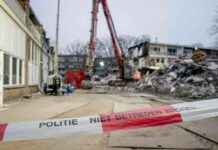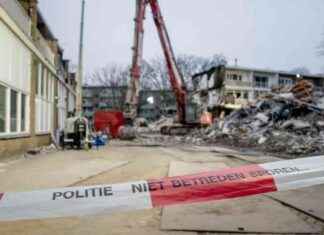what is meant is If a politician or a Manager of the “future” talk, so usually something Good. The future is not written yet, as you can still have burned a million. Yet any success, it is conceivable and possible! Associated with the word “place”, the even more solid, down-to-earth, Holding in the confusing times of the digital Revolution. In this respect, the word “future-oriented site is” a downright brilliant word. Even if hardly anyone knows what it’s supposed to mean, exactly.
The majority of the Berliners would have to be escaped, that the Senate has defined certain areas within the city, where science, research and industry work patterns are valid together, as the “future of places” – and this In the country and abroad marketed as such. The Biotech-Campus-book is considered to be such a place, just like the FUBIC, the founding centre of the FU in Dahlem.
Also, Germany’s largest technology Park in Adlershof is wearing these enigmatic title, just like the other seven sites, of which one should mention a few more of “music of the Future interest,” such as the Tegel airport, where, according to plans, the first in years, “Berlin TXL – The Urban Tech Republic”. Or the airport building in Tempelhof.
On Monday, the 11. Place in this state, The “Siemens city 2.0”, the last autumn, presented investment project, which for most people not only in the Senate, and the chief days of the Siemens group hopes to be promoted:. The members of the “control circle future places” want to decide the symbolic act of the afternoon at their Meeting at the Senate administration for the economy.
at the table in Schöneberg Secretary Barbro screwdriver as a hostess, among other things, the site managers of all the previous “future of places”, as well as representatives of the chamber of Commerce and industry (IHK), the location marketing Agency, Berlin Partner, as well as the “office of the future, places to sit next to state”.
Berlin’s economy Senator Ramona Pop (Green).Photo: Mike Wolff
“Together with Siemens, we want to. this is the traditional location of future design,” explains economy Senator Ramona Pop (Green) the step This future places to visit with your attractive areas for technology and knowledge – oriented enterprises do space for innovative ideas and creativity, she says. “They are a crucial component to Berlin’s strengths as a location for modern and future industries and technologies.”
Or to put it in a nutshell: The state government wants to show investors where to go. So, where exactly in Berlin, your money and your ideas will take.
In the on-site support policies there are a few laws of nature, at least of experience. So it is, in the case of the settlement of new research labs or technology companies, which would each city, like drops of oil on a smooth water surface: pull yourself together. Similar to this principle of coalescence, especially small and innovative companies search for geographical proximity to their peers. The Chance for a mutually fruitful exchange of ideas and sometimes staff weighs harder for you than the risk of industrial espionage by competitors. In this respect, it makes sense, the new and still small, “corporate drops” with a Label to signal how “future-oriented site”, where you can quickly and well be able to dock.
A Signal Siemens
This principle is one of the secrets of success of the technology Park Adlershof, where so far no large companies such as Zalando (sits today in Kreuzberg and Friedrichshain), but more than 1000 companies, some of which have the potential to turn the world upside down. You will see the extent to which the insurance group Allianz, the pulls soon with around 2700 employees to “Adlershof”, can change the chemistry of this “future-oriented site”.
The Siemens AG, one of the largest technology corporations in the world, headquartered in Munich, was originally founded in Berlin as an engineering office (and resided by the way, temporarily, in today’s daily mirror publishing house, at the askanischer Platz). He is today, with approximately 11,400 employees, the most significant industrial employers in Berlin. At the same time, the city is the world’s largest Siemens production site. Here, the company, for example, industry Dynamo and the largest class of gas turbine building for power plants all over the world.
Cedrik clove, member of the managing Board of Siemens AG.Photo: Carsten Koall/dpa
last fall, Siemens announced that it plans to invest on the historic grounds of the Siemens town of Spandau to the North of the Nonnendammallee, in the coming years, up to 600 million euros. It is to be built in a new area, it is so unique.
“where more than 100 years ago the life, home and Work combined, to produce a life worth living, open neighborhood of the future. Here we would like to associate the development and production of innovative technologies with a new type of residential area,“ says Cedrik clove, as a member of the Siemens group Board of management responsible for ensuring that these giants made an investment in Berlin – and not in one of the Mega-Cities of Asia, which were also up for debate.
for the “future-oriented site” vote is also a Signal that Siemens does not want to hide behind walls, but open for small, external partners. This also corresponds to the strategy of chief Executive, Joe Kaeser, has often enough made it clear that Siemens needs to be more open and flexible, to not be swept up his giant group of any fixed idea of a Start-ups from the market. Siemens wants to hear the Grass grow. Also in Berlin.
Adlershof is growing properly
but it is also True: “The Senate administration for economy, energy and operations will manage the Initiative, to combine the Strengths of future places and published in a joint innovation brand,” according to Pops management. Has instructed you thus, Roland Sillmann, chief of Wista, the operator of the largest “future place” in Adlershof. He has established the “office of the future places”.
Then, at the end of 2017, said Pops, in the meantime, geschasster state Secretary Henner Bunde (CDU), in addition to Adlershof, the other locations had a potential for growth, “which not only promoted, but, above all, more visible.”
Forgotten S-Bahn: The Siemens railway in pictures more images 1 view 837Foto: Imago/Jürgen Heinrich19.12.2018 09:30Herbst 2018. This Rest – with tracks! – . The bridge of the Siemens railway once led across the river to the S-Bahn ring.Back Next
in Short: He was the Star of the future-oriented site managers entrusted with the task, even Berlin’s other star is finally brighter. That can work, but does not have to.
Sillmann argued that the success gave him right: Since 2015 Adlershof is growing by ten percent per annum. Targeted cooperation between science and entrepreneurship lead to economic growth. “We, the state-owned Wista Management GmbH, acquired in 27 years, a lot of Knowledge. We bring with us today, with our experience as service providers, project planners and real estate developers, where we are, on behalf of the land Berlin.“ The eleven Berlin the future of the places would help to promote innovation and the competitiveness of the regional economy. The Berlin policy have asked the Wista, therefore, with the establishment of a branch office, in order to make these places even more successful than in the past.
More about
Siemens city 2.0 in Berlin-Spandau, The excavators come in two years
Whether the world brand Siemens benefits from the Label “future-oriented site”, or rather Berlin’s other “future locations” that you will be mentioned in the same breath with world brand Siemens, will show the future. In the best case, to the benefit of both.








